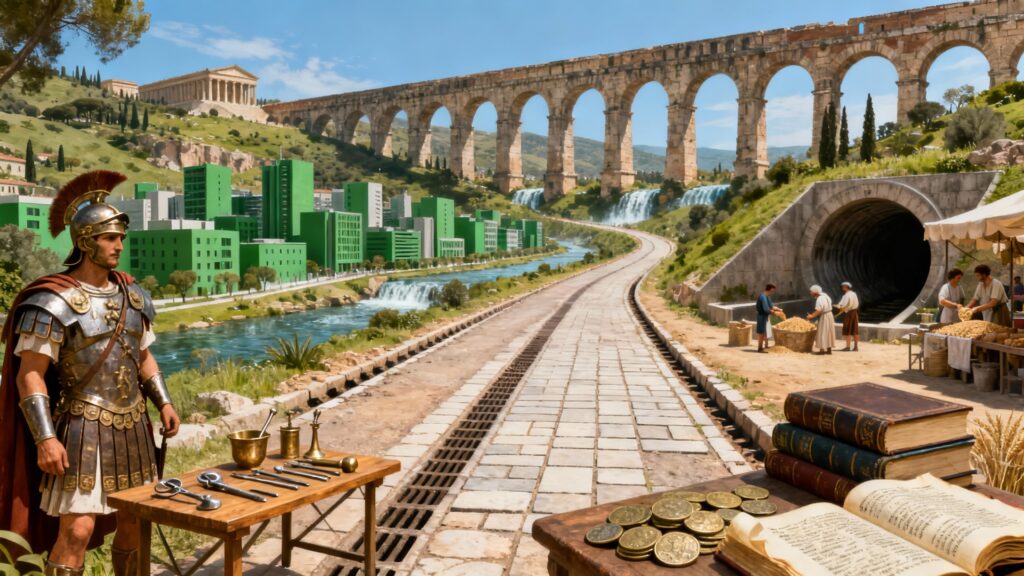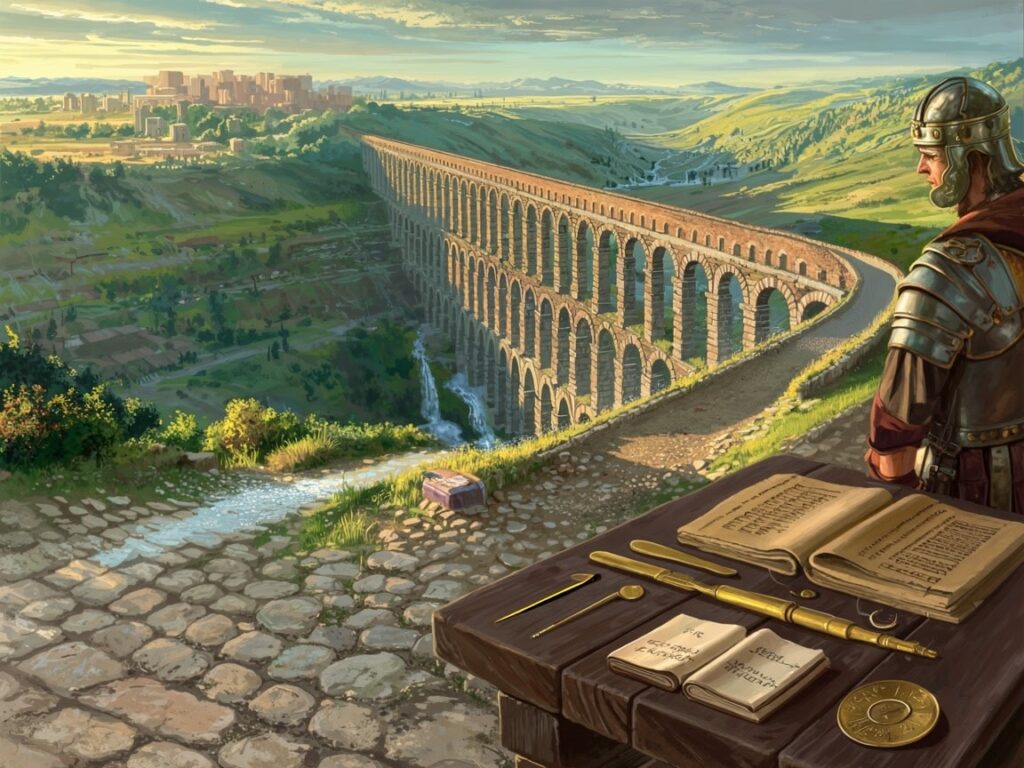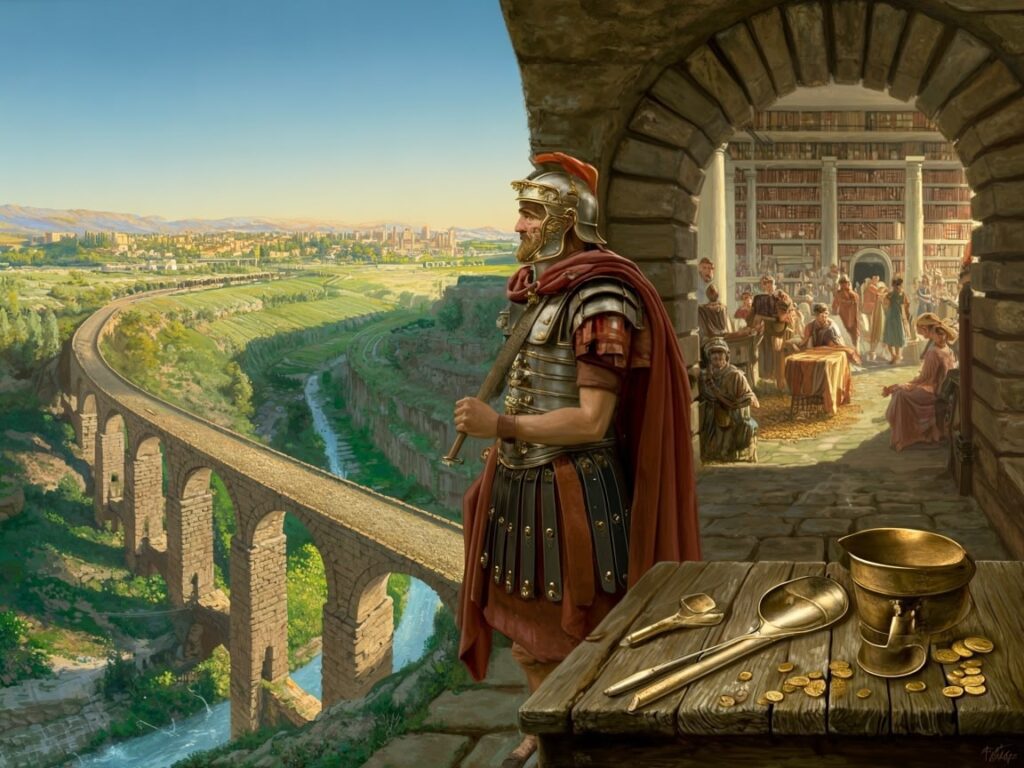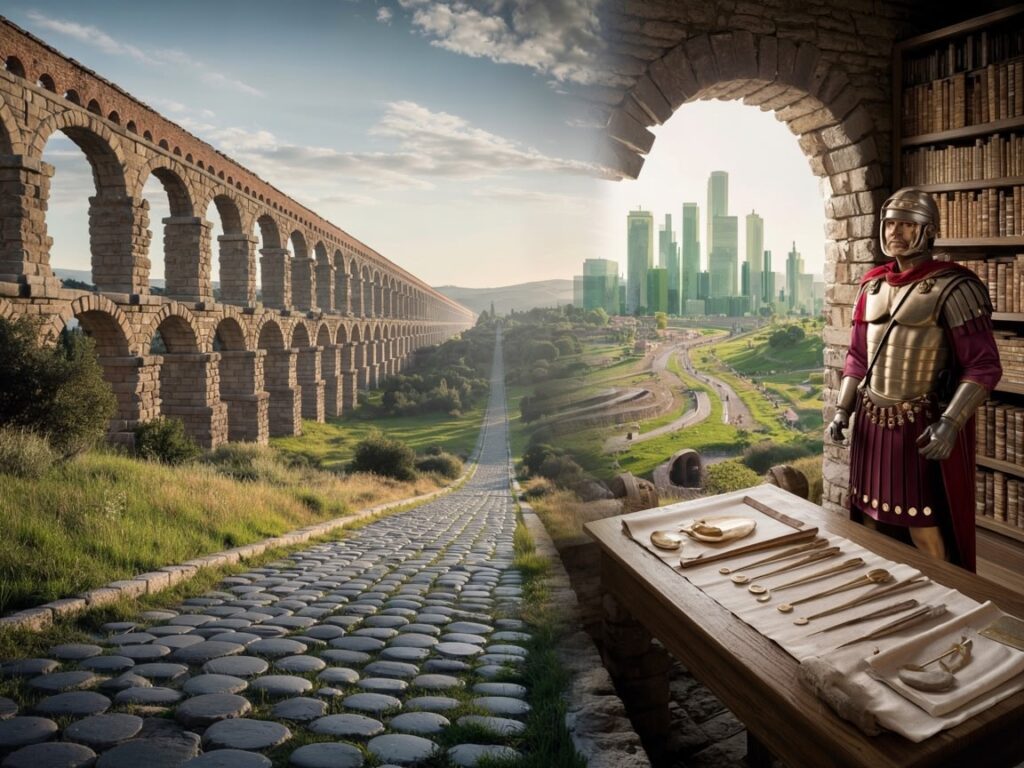Ancient Rome was a remarkable center of innovation, where creativity met practicality to create technologies that shaped the course of civilization. The legacy of Roman inventions includes engineering wonders, legal principles, and social systems that form the foundation of many aspects of modern life. Roman innovations established essential groundwork—from sturdy building materials to advanced public health systems—that continue to impact our world today.
This article explores the legacy of lost Roman inventions—those groundbreaking ideas and technologies often overlooked or forgotten—that have the potential to transform modern life. By revisiting these ancient accomplishments, we can discover how ancient Roman innovation can inspire sustainable construction, efficient urban planning, social welfare models, and more. Understanding these contributions offers a new perspective on tackling present-day challenges with age-old wisdom.
The Influence of the Roman Empire
The Roman Empire was not only known for its technological advancements but also for its significant influence on various aspects of society:
- Coins as Propaganda: Coins were used as propaganda by emperors to convey their authority and legitimacy. These small pieces of currency served a purpose beyond mere transactions—they became powerful tools for political messaging.
- The Power of the Roman Military: The Roman military was a well-oiled machine that combined discipline, strategy, and innovation. At its peak, it reflected the empire itself—vast, diverse, and intricately structured.
- Gods of Power, Justice, and Wisdom: The Roman Pantheon consisted of a diverse collection of gods and goddesses worshipped in ancient Rome. This pantheon represented the values, beliefs, and customs that influenced the lives of its people, with important figures embodying power, justice, and wisdom at its core.

The Engineering Marvels of Ancient Rome
Roman Concrete: A Blueprint for Sustainable Construction
Roman concrete stands out as one of the most remarkable engineering innovations of Ancient Rome. Its unique composition and properties have enabled structures built millennia ago to withstand the test of time, inspiring modern efforts in sustainable building materials.
Composition and Unique Properties
- Roman concrete was made using a mixture of volcanic ash, lime (calcium oxide), and seawater.
- The volcanic ash contained minerals that triggered chemical reactions, producing a robust binder.
- Unlike modern Portland cement, this blend formed crystalline structures that enhanced strength over time.
Self-Healing Ability
- When cracks appeared in Roman concrete, the lime clasts reacted with water infiltrating these fissures.
- This reaction produced calcium carbonate, effectively sealing cracks and preventing deterioration.
- This self-healing property explains why Roman harbors and aqueducts remain intact despite constant exposure to harsh marine environments.
Longevity Demonstrated by Enduring Structures
- Ancient constructions such as the Pantheon’s massive dome and the Pont du Gard aqueduct exemplify the durability of Roman concrete.
- These structures have survived earthquakes, floods, and centuries of weathering without significant repairs.
- Their endurance showcases how material science was leveraged by Romans to create infrastructure meant for generations.
Modern Research Efforts
- Scientists today study Roman concrete’s formula with hopes to replicate its eco-friendly and durable nature.
- Current concrete production accounts for significant global CO2 emissions; adopting Roman techniques could reduce environmental impact.
- Projects exploring mixtures incorporating volcanic ash or similar pozzolanic materials aim to develop self-healing concrete for sustainable construction.
The legacy of Roman concrete offers a powerful model for rethinking how we build in the modern era. Its combination of natural materials and innovative chemistry serves as a valuable blueprint for creating long-lasting, environmentally responsible infrastructure.

Roads: Pioneering Infrastructure for Connectivity
Roman roads are a remarkable example of precise engineering and forward-thinking infrastructure development. The principles behind their design were centered around creating straight, wide, and well-drained pathways that made it easier to travel across large areas.
Key features of Roman road construction include:
- Straight Alignment: Roman engineers prioritized direct routes, minimizing unnecessary curves. This approach reduced travel time and simplified navigation.
- Wide Pathways: Roads were built wide enough to accommodate two-way traffic of carts and troops, promoting smooth logistics and military deployment.
- Drainage Systems: Roads featured cambered surfaces with side ditches to prevent water accumulation, crucial for maintaining structural integrity over time.
Construction techniques contributed to remarkable durability:
- Multiple layers of materials provided stability and load distribution, including compacted soil, gravel, and paving stones.
- Use of Roman concrete in certain road sections enhanced strength and longevity.
- Meticulous foundation preparation ensured resistance against erosion and wear.
The influence of Roman roads extends deeply into modern urban planning and road-building practices. Their emphasis on durability, connectivity, and drainage informs contemporary highway engineering standards worldwide. Understanding these ancient methods inspires sustainable infrastructure solutions today, complementing innovations like Roman concrete properties in eco-friendly construction.
Roman roads exemplify how lost inventions can still guide the development of resilient transportation networks—an enduring legacy shaping modern civilization’s backbone alongside aqueducts and other infrastructure marvels.

Aqueducts: Engineering Fresh Water Supply Systems
Roman aqueducts are an incredible example of ancient engineering, created to transport fresh water over long distances with great accuracy and efficiency. These systems stretched for hundreds of miles, bringing water from faraway sources into cities, where it was used in public baths, fountains, private homes, and farms.
Key features include:
- Sophisticated gradient control: Aqueducts maintained a gentle and consistent slope, allowing gravity to move water smoothly without pumps.
- Durable construction materials: Use of Roman concrete with volcanic ash ensured longevity and resistance to water erosion.
- Arched bridges and tunnels: Innovative structures overcame natural obstacles like valleys and hills.
The impact on public health was significant. Having reliable access to clean water helped reduce the spread of diseases caused by contaminated sources and poor sanitation. As a result, cities were able to grow and support larger populations with better hygiene and comfort.
Modern infrastructure can learn from these ancient systems:
- Using sustainable building materials like self-healing Roman concrete offers eco-friendly options for water channels.
- Applying precise engineering techniques for regulating flow can improve current water management practices.
- Recognizing the importance of centralized, well-maintained supply networks is vital for effective urban planning.
The legacy of Roman aqueducts continues to inspire efforts in tackling today’s issues related to sustainable water distribution and resilient infrastructure.

Innovations in Public Health and Sanitation
Ancient Rome’s contributions to public health and sanitation remain a cornerstone in the history of urban development. The sophistication of Roman sewers and sanitation systems represents one of the earliest large-scale efforts to manage waste and maintain hygiene in densely populated cities. These advancements not only improved the quality of life for Roman citizens but also laid foundational principles that continue to influence modern urban sanitation solutions.
Advanced Sewer Systems: Foundations of Modern Waste Management
By around 100 AD, the Romans had integrated extensive sewer networks that connected individual homes, public baths, fountains, and latrines to centralized drainage systems. This integration was revolutionary for its time and crucial for effective waste management. The most famous example, the Cloaca Maxima in Rome, functioned as a massive drainage channel that efficiently removed wastewater from the city center into nearby rivers.
Key features of Roman sewer networks:
- Connectivity: Individual households were linked into a broader network, ensuring waste was carried away from residential areas.
- Engineering Precision: Sewers were built with gradients to encourage flow using gravity, preventing stagnation.
- Durability: Construction materials and techniques ensured longevity; many sections remain intact today.
- Public Health Impact: By diverting waste efficiently, these systems helped reduce contamination of drinking water sources and limited outbreaks of disease.
Roman innovations in sanitation extended beyond sewers. Public latrines connected to these networks promoted community hygiene practices while reducing direct contact with human waste. Aqueducts supplied fresh water that facilitated regular cleaning and bathing — key factors in controlling disease spread.
The legacy of Roman sewer systems offers valuable lessons for today’s urban sanitation challenges:
- Integrated waste management remains critical as modern cities grow in population density.
- Designing infrastructure with durability and maintenance in mind ensures long-term functionality.
- Effective drainage reduces environmental contamination risks and protects public health.
Modern engineers and city planners often look back at ancient Rome’s sanitation ingenuity when devising sustainable urban solutions. Rediscovering how the Romans approached these problems can inspire innovative, eco-friendly designs that address current needs without sacrificing efficiency or resilience.
Roman sewers stand as a testament to how thoughtful engineering can directly improve societal well-being — an enduring example from The Legacy of Lost Roman Inventions That Could Change Modern Life Today.
Social Welfare Programs in Ancient Rome That Could Inspire Modern Policies Today
Ancient Rome was not only remarkable for its engineering and legal achievements but also for its early experiments in social welfare. The empire recognized the importance of supporting vulnerable populations, setting precedents that resonate with modern social policy frameworks. These initiatives demonstrate how state involvement in welfare can stabilize society and promote civic harmony.
Lessons from Ancient Rome’s State-Sponsored Feeding Programs
Emperor Augustus pioneered one of the earliest large-scale social welfare programs by instituting state-sponsored food distributions, known as the cura annonae. Recognizing that feeding the urban poor was essential to maintaining public order and preventing unrest, Augustus expanded grain subsidies to a broad segment of Rome’s population.
Key features of these feeding programs include:
- Wide Reach: The program provided free or heavily subsidized grain to tens of thousands of citizens, effectively acting as an early form of food security.
- State Management: Rather than relying solely on charity, the Roman government took direct responsibility for procurement and distribution, ensuring consistent supply.
- Political Stability: By addressing basic needs, these programs helped reduce social tensions and contributed to the longevity of Augustus’s rule. However, it’s important to note that such stability was not guaranteed forever. Political instability and weak leadership eventually led to the decline of the Western Roman Empire, serving as a stark reminder of how fragile such structures can be.
The cura annonae serves as a historical example of how governments can implement structured social welfare policies that go beyond emergency relief. It highlights the potential benefits of proactive intervention in preventing poverty-related crises rather than reacting after they occur.
Modern policymakers can draw inspiration from this ancient model in several ways:
- Food Security as a Public Good: Ensuring access to basic nutrition remains a cornerstone of social welfare today.
- Governmental Role in Welfare Delivery: Direct state involvement can increase efficiency and equity compared to fragmented charitable efforts.
- Preventive Approach: Early intervention reduces long-term societal costs associated with poverty and instability.
Understanding social welfare ancient Rome history through Emperor Augustus’s feeding programs reveals that many concepts underpinning contemporary welfare systems have roots dating back over two millennia. These historical lessons underscore opportunities for adapting proven strategies to address modern challenges such as hunger, inequality, and social inclusion.
Additionally, exploring other facets like trade and economy in ancient Rome can provide further insights into how economic practices shaped one of history’s most powerful civilizations. These aspects are crucial in understanding the broader context within which these social welfare programs were implemented.
Moreover, studies have shown that certain principles underlying these ancient welfare systems still hold relevance today. For instance, a study published on PMC highlights how structured interventions can lead to significant improvements in societal well-being. This reinforces the idea that learning from history can provide valuable insights into creating effective modern welfare policies.

Communication Innovations That Shaped Information Sharing Practices We Use Today
The codex format history marks a major turning point in the way information was recorded and shared. Ancient Rome contributed significantly to this transformation by pioneering the shift from scrolls to bound books made of wooden or parchment leaves. This innovation laid the foundation for the modern book, influencing publishing formats that persist today.
Key Features of the Codex Format
- Bound Leaves Instead of Scrolls: The codex replaced cumbersome scrolls with a collection of individual pages bound along one edge. This made it easier to flip through content, search for specific information, and preserve texts.
- Increased Portability: Unlike scrolls, codices were compact and durable, allowing readers to carry multiple volumes more conveniently. This accessibility encouraged wider distribution and sharing of knowledge across different regions.
- Enhanced Durability: The materials used—wooden tablets or treated parchment—provided a longer lifespan compared to fragile papyrus scrolls susceptible to damage.
The legacy of lost Roman inventions like the codex demonstrates how small technical changes can revolutionize entire fields. By improving access to written works, Romans enabled the spread of ideas, religious texts, legal documents, and scholarly writings in ways that shaped literacy and education for centuries.
Modern publishing owes much to this ancient innovation. Printed books continue to use the codex format’s basic design principles, highlighting its enduring practicality. Libraries, schools, and digital platforms build on this structure by organizing content into pages or screens that mimic the ease of navigation introduced by Roman codices.
Understanding codex format books history opens doors to appreciating how Roman ingenuity still impacts our daily interaction with information. This evolution from scrolls to bound books not only preserved knowledge but also democratized it—offering lessons on how future innovations might similarly transform communication in an age increasingly dominated by digital media.
Acta Diurna: The World’s First Newspapers That Promoted Transparency
The Romans introduced a groundbreaking communication innovation known as Acta Diurna, often considered the world’s first newspapers. These daily public notices were carved on stone or metal and posted in prominent places around Rome, making information accessible to a broad audience.
Content covered in Acta Diurna included:
- Official news from the government and military updates
- Sports results from gladiatorial games and other public events
- Family notices such as births, marriages, and deaths
- Senate activities including debates and decisions
This early form of information sharing played a critical role in fostering transparency within Roman society. Citizens stayed informed about political decisions, social events, and public affairs, which helped promote an engaged and informed populace.
The legacy of Acta Diurna echoes in today’s media landscape. Much like modern newspapers and digital news platforms, these early publications served as tools for accountability and public awareness. Their existence highlights how ancient innovations in communication—tied closely with the codex format history—laid foundational practices for distributing knowledge effectively.

Legal Principles Rooted in Roman Jurisprudence That Still Guide Justice Systems Worldwide Today
Ancient Rome laid down foundational legal concepts that have deeply influenced justice systems across the globe. The Roman law legacy is vast, shaping not just laws but the very principles of fairness and due process that define modern jurisprudence. Among these enduring contributions, the principle of innocent until proven guilty stands out as a key element still embedded in legal practices worldwide.
Presumption of Innocence: A Core Principle in Modern Justice Systems
The presumption of innocence traces its roots directly to Roman legal thought. In Roman courts, the burden of proof was placed on the accuser rather than the accused, establishing a fair trial framework that protects individuals from wrongful punishment based purely on accusation. This concept is a cornerstone of justice, emphasizing that no one should be considered guilty without sufficient evidence presented during a lawful process.
Key aspects of this Roman legal principle include:
- Burden of Proof: The responsibility lies with prosecutors to prove guilt beyond reasonable doubt.
- Protection Against Arbitrary Punishment: Safeguards individuals from conviction based solely on suspicion or hearsay.
- Fair Trial Rights: Ensures accused persons have the opportunity to defend themselves fully before judgment.
The presumption of innocence has been adopted and adapted by numerous modern legal systems, including common law and civil law traditions. It underpins human rights protections and fair trial standards codified in international documents such as the Universal Declaration of Human Rights and various national constitutions.
Roman jurists also contributed to categorizing laws into public and private spheres, defining contracts, property rights, and torts—concepts that remain integral to contemporary legislation. These structural elements provide a clear framework for governing society and resolving disputes effectively.
The historical significance of Roman law history extends beyond rules; it established a rational, systematic approach to justice that balances state authority with individual rights. This legacy shapes how courts operate today, promoting transparency and accountability while protecting personal freedoms.
In embracing these Roman legal inventions, modern societies gain access to time-tested principles that promote fairness and trust in their judicial systems. The presumption of innocence is not only a legal technicality but a moral imperative rooted deeply in Rome’s vision of justice—a vision still relevant when addressing complex legal challenges in today’s world. Additionally, the influence of Roman society on Western civilization has been profound, affecting various aspects of modern life beyond just the legal realm.
Medical Advancements Inspired by Roman Practices That Are Relevant for Healthcare Development Today
Ancient Rome’s contributions to medicine extend beyond simple remedies and herbal treatments. Their innovations in battlefield medical care laid foundational principles that still resonate in modern emergency medicine.
The Roman battlefield medicine history reveals a sophisticated approach to surgical techniques and emergency care, designed to improve survival rates under extreme conditions. These practices form an integral part of The Legacy of Lost Roman Inventions That Could Change Modern Life Today.
Innovations in Battlefield Medical Care That Inform Emergency Response Practices Today
Roman military campaigns demanded efficient medical systems capable of treating large numbers of wounded soldiers quickly and effectively. This necessity drove advancements that influenced both ancient and modern healthcare systems.
Key features of Roman battlefield medical care included:
- Specialized military medical personnel: Known as medici, these individuals received training in wound treatment, surgery, and basic diagnostics. This professionalization resembles the specialization found in today’s paramedics and combat medics.
- Field hospitals (valetudinaria): Romans established dedicated medical facilities near battle zones. These structures provided triage, wound care, and convalescence areas. The concept parallels modern mobile field hospitals used in conflict zones and disaster relief operations.
- Surgical tools and techniques: Archaeological finds reveal surgical instruments such as scalpels, forceps, bone drills, and catheters crafted from bronze or iron. Their design was surprisingly advanced for the time, enabling procedures like draining abscesses, extracting arrows, and setting fractures.
- Use of antiseptics and wound care: Romans utilized substances such as honey, vinegar, and wine for their antiseptic properties to clean wounds. They also employed dressings made from wool or lint soaked in herbal solutions to prevent infection—a precursor to sterile bandaging practices today.
- Pain management: While anesthesia was rudimentary compared to modern standards, substances like opium poppy derivatives were used to alleviate pain during surgery.
Impact on modern emergency response:
- The emphasis on rapid triage—assessing injuries quickly to prioritize treatment—originated from Roman military protocols. This principle remains central to modern emergency medical services (EMS).
- Establishing mobile care units close to injury sites reflects current strategies employed by ambulance services and military medics aiming to reduce the time between injury and treatment.
- The meticulous design of surgical instruments inspired by Roman tools enhances the ergonomic efficiency seen in contemporary devices used in trauma care.
- Practices involving antiseptic cleaning of wounds anticipate the germ theory developments that revolutionized infection control centuries later.
Lessons drawn from Roman battlefield medicine history:
- Systematic organization of medical personnel with clearly defined roles improves patient outcomes during mass casualty events.
- Infrastructure investment for emergency medical facilities near conflict or disaster areas saves lives by reducing treatment delays.
- Continuous innovation in surgical tools tailored for specific injuries enhances procedural success rates.
- Integration of natural antiseptics into wound management underscores the importance of accessible first-aid measures even before advanced pharmaceuticals.
Roman advances in battlefield medicine demonstrate a blend of practical ingenuity and clinical foresight rarely credited outside historical circles. Their legacy provides valuable insights for healthcare development today, especially within trauma care, emergency response frameworks, and military medicine evolution.
Exploring these innovations deepens appreciation for how ancient knowledge informs contemporary practice. Rediscovering such lost inventions could inspire novel approaches to managing injuries more effectively.
FAQs (Frequently Asked Questions)
What are some lost Roman inventions that could transform modern life today?
Lost Roman inventions such as Roman concrete with self-healing properties, advanced road-building techniques, extensive aqueduct networks, sophisticated sewer systems, state-sponsored feeding programs, the codex book format, early newspapers like Acta Diurna, foundational legal principles like presumption of innocence, and innovations in battlefield medical care have the potential to significantly influence and improve modern infrastructure, public health, social welfare, communication, justice systems, and healthcare development.
How did Roman concrete contribute to sustainable construction practices?
Roman concrete was composed of volcanic ash and lime clasts which endowed it with unique self-healing abilities and exceptional longevity. This durable material allowed for the construction of enduring structures that have lasted millennia. Modern research aims to replicate this formula to develop eco-friendly and durable building materials that can revolutionize sustainable construction today.
In what ways did Roman roads influence modern infrastructure?
Roman roads were engineered with straight, wide, and well-drained designs employing construction techniques that ensured durability over vast distances. These pioneering infrastructure principles have profoundly influenced modern road-building methods and urban planning by emphasizing connectivity and long-lasting quality.
What role did Roman aqueducts play in public health and urban development?
Roman aqueduct networks supplied fresh water extensively to cities which greatly improved public health by providing clean water access. Their engineering marvels offer valuable lessons for contemporary water management and infrastructure development aimed at enhancing urban living conditions.
How did ancient Rome’s social welfare programs inspire modern policies?
Ancient Rome implemented early state-sponsored feeding programs initiated by Emperor Augustus which provided food for the needy. These initiatives serve as historical models for modern social welfare policies by demonstrating effective government involvement in supporting vulnerable populations.
What communication innovations introduced by Romans shaped today’s information sharing practices?
Romans transitioned from scrolls to the codex format—bound wooden or parchment leaves—which increased portability and accessibility of books. Additionally, they created Acta Diurna, considered the world’s first newspapers promoting transparency through official news dissemination. These innovations laid foundational groundwork for modern publishing formats and media practices.

